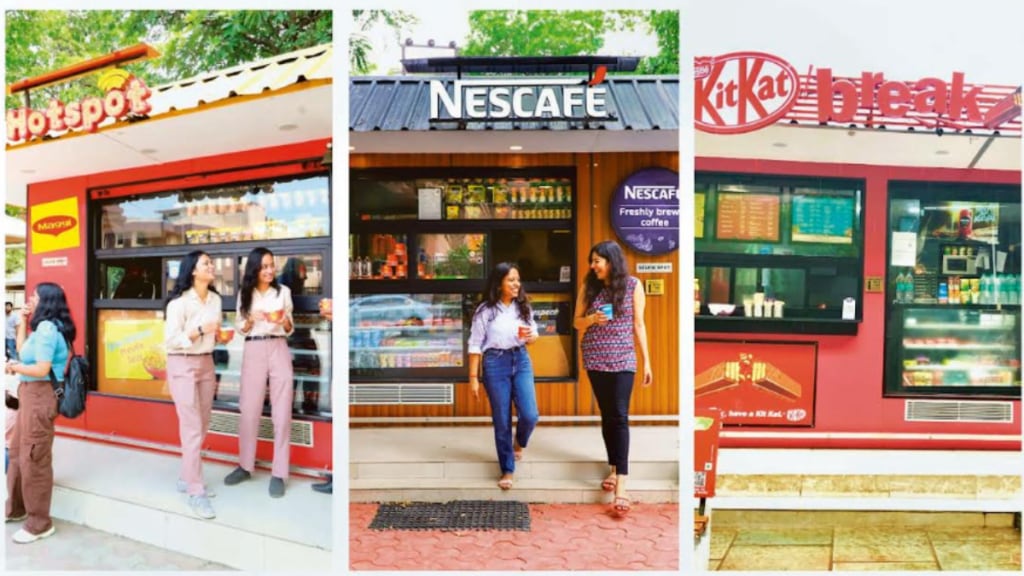A report by Swiggy and Bain & Company estimates the Indian food services market to reach `9-10 lakh crore by 2030, at a CAGR of 10-12% between 2023 and 2030. The same report says India eats out at an average of five occasions a month, which go up to around 7-8 times by 2030.
If Nestlé’s out-of-home retail plans stay on track, the process will only gain speed.
Nestlé Professional, the out-of-home business unit of Nestlé India, has expanded its Retail ONE branded food kiosk network to 1,000 units across the country. The network comprises Nescafe Corners, Maggi Hotspots, and Kitkat Break Zones, located in high footfall areas such as educational institutions, healthcare centers, and travel hubs.
Women and specially abled individuals
The initiative is supported by a workforce that includes a significant number of women and specially-abled individuals. Says Saurabh Makhija, head, Nestlé Professional, Nestlé India, “Our strategic growth plan focuses on increasing visibility and accessibility in key sectors, including education and healthcare, as well as targeting tourism hotspots.”
The model is a collaborative one: the company supports operators through branding, ingredient sales, and comprehensive guidance on the business model, while they manage day-to-day operations, including the associated capital and operational expenditure. Some operators have rapidly expanded their kiosk numbers over the years, the company says, managing as many as 40 kiosks across various channels, while others have established a significant presence at religious institutions such as the Guruvayur Temple in Kerala, Baba Mandir in Sikkim, and Golden Temple in Amritsar. “The adaptability of the model allows businesses to be initiated wherever there is a capable and willing entrepreneur and an opportunity to be seized,” explains Makhija.
The kiosks serve an important purpose — they are powerful brand touchpoints, enhancing recall by embedding products in daily routines, points out Yasin Hamidani, director, Media Care Brand Solutions. “These retail carts are highly viable for large FMCG players in India, particularly in tier 2 and 3 cities, where modern trade penetration is lower. These formats offer low capex, quick setup, and high consumer proximity,” he says.
They also double up as data-rich environments for understanding consumer behaviour, testing innovations, and building a sense of community around the brand, adds Sushant Vatsyayan, general manager, UNICO. Design, merchandising, and digital engagement further create interactive connections with consumers.
Together, these elements ensure that every kiosk interaction embodies Nestlé’s core values and quality. The goal: to embody a one-company approach that emphasises consistency across brands.
Take a break
The opportunity is huge. The organised food kiosk and micro-retail segment in India was valued at approximately 3,000–3,500 crore ($360–420 million) in 2024 and is projected to grow at a CAGR of 12–15% over the next five years. “Moreover, the broader kiosk and cart-based food services market, including unorganised and semi-organised formats, exceeds25,000 crore ($3 billion), indicating significant formalisation potential,” says Avanish Agarwal, founder of Nutriia.
Still, the company faces stiff competition. “Nestlé ONE faces multi-layered competition across three distinct segments,” points out Mukul Goyal, co-founder of Stratefix Consulting. In FMCG branded kiosks, Hindustan Unilever leads with Knorr kiosk pilots and Swirl ice cream parlours, whilst ITC leverages its diversified portfolio and strong rural penetration, he says. Second, the QSR segment presents formidable rivals; McDonald’s operates dessert kiosks and McCafe formats, Domino’s plans 800+ stores with kiosk implementation, and KFC maintains 1,000+ outlets as India’s fastest-growing QSR. Third, emerging threats include pure-play vending specialists like Vendekin Technologies, Daalchini, and Vendiman, offering IoT-enabled smart retail solutions. Specialty chains like Barista Coffee are also deploying kiosk formats in high-footfall locations, Goyal adds.
Scaling kiosks can also pose hurdles. The brand must try to maintain consistency in quality, manage logistics in remote areas, and ensure franchisee training, Hamidani points out. Regulatory compliance, space availability in high-footfall areas, and adapting menus to regional tastes is also very important.
“The key success factors include smart location strategy, ease of operations, local menu innovation, and the ability to maintain product consistency across dispersed geographies,” concludes UNICO’s Vatsyayan.

